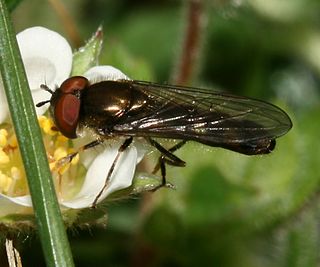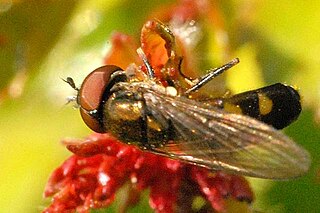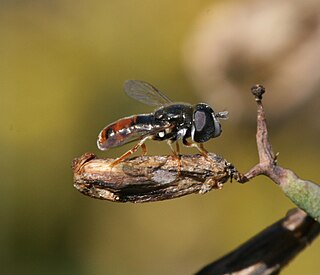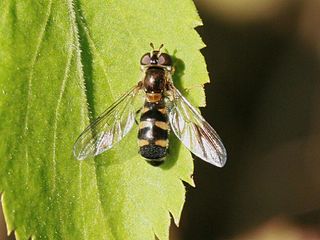
Melanostoma mellinum is a very common species of hoverfly found in many parts of Britain, Europe including the Mediterranean basin and North Africa, the East Palearctic, and North America.

Criorhina berberina is a species of hoverfly. It is found in the Palaearctic from Fennoscandia South to Iberia and Italy. Ireland eastwards through Europe into Turkey and European Russia . C. berberina is a bumblebee mimic. The body has uniformly long dense pubescence, obscuring the ground-colour. There are two forms one with the pubescence more or less extensively blackish, one in which it is entirely yellow or tawny. Criorhina differ from other bumblebee mimics - Mallota, Arctophila, Pocota and Brachypalpus by the form of their antennae: the first segments are thin and form a stalk, the third segment is shorter than it is wide. In Criorhina, the face projects downwards, in contrast to Pocota and Brachypalpus.

Baccha elongata is a species of hoverfly in the genus Baccha.

Platycheirus albimanus is a common widespread species of hoverfly. A holarctic species its range includes Greenland, Iceland, Britain, mainland Europe, Russia, across Siberia to the pacific coast, the Philippines, Alaska, western Canada and United States.

Platycheirus fulviventris is a Palearctic species of hoverfly. It is found in many parts of Britain and Europe.

Platycheirus manicatus is a species of hoverfly. It is found across the Palearctic and in Alaska.

Platycheirus splendidus is a species of hoverfly. It is found in many parts of Britain and Europe.

Platycheirus rosarum is a species of hoverfly found in the Palearctic. Like its close relative Platycheirus granditarsus, it can be found in marshy meadows and ditches; indeed, the two species can often be found together. The flight time is between May and October, though it peaks in abundance in June and July.

Anasimyia contracta is a European species of hoverfly.

Platycheirus ambiguus is a small widespread species of hoverfly found across the Palearctic from Ireland to Japan. A spring species found in flight in April and May, it visits spring-flowering trees and shrubs; e.g., Prunus spinosa in deciduous woodland and scrub.

Platycheirus angustatus is a species of hoverfly. It is found in many parts of the Palearctic, and in the Nearctic.
Platycheirus europaeus is a Palearctic species of hoverfly. It is found in many parts of Europe and eastern Asiatic Russia The habitat is brook floodplains and wet flushes in montane grassland and beside streams or flushes in forest in the Carpinus and Quercus zone up into the Fagus and Picea/ Pinus zone. Flies among grasses from May to August. Flowers visited include Graminae and Cyperaceae, Ranunculus, Taraxacum.
Platycheirus nielseni is a Holarctic species of hoverfly.
Platycheirus ramsaerensis is a Palearctic species of hoverfly. It is found along the parts of northern Europe that face the Atlantic. It is a member of the Platycheirus clypeatus group

Paragus tibialis, is a species of hoverfly found in many parts of Europe and North Africa. It has a preference for drier areas and its larvae feed on root aphids.
Paragus constrictus is a species of hoverfly. It is found in Southern Sweden and Denmark, Ireland, Spain, Germany, the French Alps, Switzerland, Austria, Italy, Yugoslavia and Turkey and Russia east of the Urals. This species may be distinguished from Paragus tibialis only by the shape of the male parameres. In both sexes it shares with P. tibialis the character of entirely pale-haired abdominal tergites, so it is distinct from Paragus haemorrhous which has dark hairs. Images representing Paragus constrictus

Paragus albifrons, is a species of hoverfly. It is found from southern Europe across to eastern Asia.

Meligramma triangulifera is a European species of hoverfly. It was described by Zetterstedt in 1843.
Melanostoma dubium is a Palearctic species of hoverfly.

Dasysyrphus pinastri is a species of hoverfly found in Europe.















